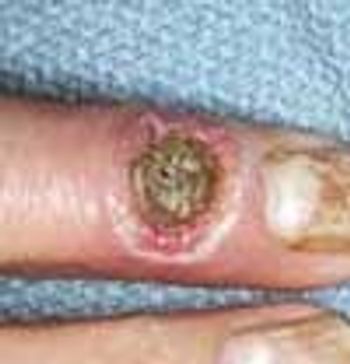
SCOTTSDALE, Ariz. - The two-hour oral glucose tolerance test - often avoided by busy physicians - should be part of the diagnostic work-up for patients with chronic idiopathic axonal neuropathy, researchers here contend.

SCOTTSDALE, Ariz. - The two-hour oral glucose tolerance test - often avoided by busy physicians - should be part of the diagnostic work-up for patients with chronic idiopathic axonal neuropathy, researchers here contend.

WASHINGTON - Liraglutide, an investigational injectable drug for type 2 diabetes, has produced significant decreases in HbA1c levels, as well as significant and sustained weight loss, according to phase 2 studies.

WASHINGTON - Tight glucose control leading to episodes of hypoglycemia in patients with type 1 diabetes does not appear to lead to cognitive problems, as some had feared, researchers reported here.

WASHINGTON ? Among patients who live more than 50 years with type 1 diabetes, a significant proportion show evidence of a residual population of insulin-secreting beta islet cells, according to research presented here.

WASHINGTON ? Januvia (sitagliptin), an investigational oral agent for type 2 diabetes, appears to be effective when given as a monotherapy or as an adjunct to Glucophage (metformin) or Actos (pioglitazone), reported researchers here.

WASHINGTON ? If medications for four optimal therapeutic goals of diabetes could be combined into a single pill, the risk of diabetes related heart attacks could be cut in half over the next 30 years.

WASHINGTON ? Antidepressant medications appears to further increase the risk of developing type 2 diabetes in those with impaired glucose tolerance, researchers reported here.

WASHINGTON ? More than three hours a day would be required of patients with type 2 diabetes to follow to the letter all recommended tasks for home care, researchers reported here

WASHINGTON ? Preeclampsia is an independent risk marker for type 2 diabetes, even when gestational diabetes is taken into account, reported researchers here today.

WASHINGTON ? Postmenopasual women with high levels of estradiol and testosterone are at a greatly increased risk for developing type 2 diabetes, according to data from the reported Women's Health Study.

TEMPLE, Tex. - Diabetics who develop foot infections have a 55-fold greater risk of being hospitalized than diabetics without foot infections and a 154-fold higher risk of losing the affected foot, found a multicenter study.

Diabetic nephropathy, the leading cause of end-stage renal disease (ESRD) in the United States, affects 20% to 30% of patients with diabetes. Early diagnosis and aggressive treatment may delay the progression of kidney disease.

MANCHESTER, England ? An investigational gene therapy offers promise for diabetic neuropathy, investigators here reported.

My 46-year-old patient had a fasting plasma glucose level of 115 mg/dL; a followupfasting plasma glucose level was 116 mg/dL.

Diabetes is epidemic! The numbersare truly alarming. In 1997, official datashowed that 16 million people in theUnited States had diabetes. Approximately1 million had type 1 disease,and 10.4 million had type 2 disease; theremainder had undiagnosed diabetes.1If these numbers are projected outagainst an annual increase in diseaseprevalence of about 3.5%, it means thatby the year 2028, 50 million people willhave diabetes. However, the actual rateis closer to 7% each year. As such, approximately100 million Americans-roughly 1 of every 4-will have diabetesby 2028.

Have any specific genes been identified for type 1 or type 2 diabetes? If so, howmany genes are involved?

A 49-year-old man presents for a routine examination. He has a 15-year history of essential hypertension and a 7-year history of hypercholesterolemia and type 2 diabetes mellitus.

Breast Infection in a Woman With Diabetes

A 49-year-old man presents for a routineexamination. He has a 15-yearhistory of essential hypertension anda 7-year history of hypercholesterolemiaand type 2 diabetes mellitus.The patient has lost 7.5 lb in the past3 months. The physical examinationis remarkable for a blood pressure(BP) of 168/94 mm Hg and a palpablemidline epigastric mass that isnontender, firm, and immobile.

The prevalence of type 2 diabetes is expected to continue to increase rapidly, and it is not surprising that the issue of the potential effects of different classes of antihypertensive drugs on glucose metabolism and glycemic control has sparked debate.

During the past decade or so, a multitude of weapons have emerged in the battle against the complications of diabetes mellitus.

Up to 10% of Americans older than 20 years have type 2 diabetes, and more than 20% have the metabolic syndrome. The prevalence of both diseases has risen by 33% over the past decade as a result of an increasingly sedentary lifestyle, the obesity epidemic, the growth of ethnic groups at risk for the disease, and the aging of the population.

Researchers in the Netherlands investigating the relative risks of common infections in patients with type 1 or type 2 diabetes mellitus (DM1 or DM2, respectively) determined that both groups are at increased risk for lower respiratory tract infection, urinary tract infection, and skin and mucous membrane infection.

The growing epidemic of type 2 diabetes makes it imperative to identify persons at risk, screen for impaired glucose tolerance (IGT), and treat to prevent progression. Calculation of body mass index (BMI) is an appropriate starting point for identification of patients with possible IGT.

Cutaneous manifestations develop in approximately 30% of persons with diabetes. Premature atherosclerosis is a common complication of the disease that can cause peripheral infarction, ulceration, and necrosis.